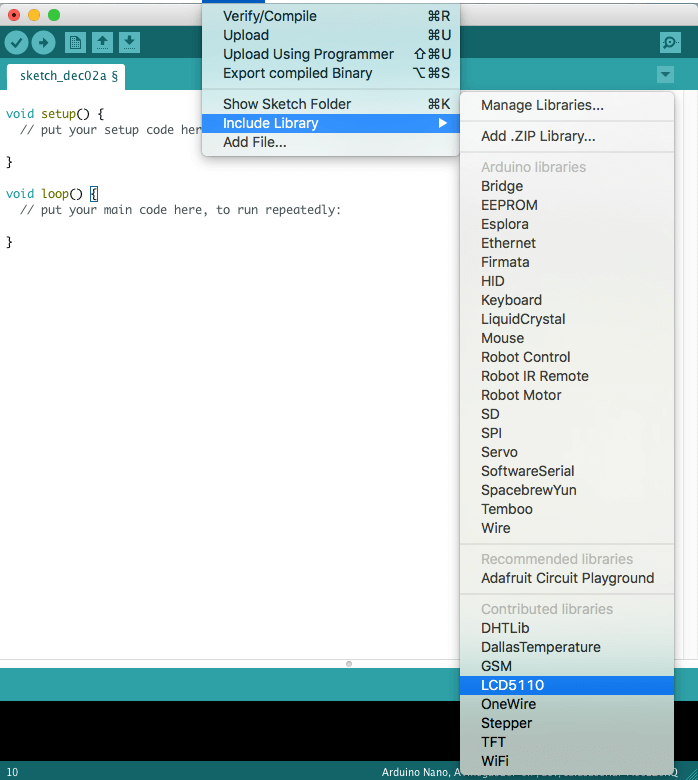

- #Arduino libraries directory install#
- #Arduino libraries directory zip file#
- #Arduino libraries directory update#
- #Arduino libraries directory software#
- #Arduino libraries directory code#
#Arduino libraries directory code#
You can reduce code duplication and make updates easier by using Git submodules. You can commit your entire project to GitHub (private or public), including the lib directory. The fake library can contain multiple files, but it should only contain. That further contains a src directory, which contains the actual library source. In this example, there is a "non-library" called SharedUtilities in the lib directory. When using Workbench the lib directory can contain things that are not actually Particle libraries, as long as they have the correct directory structure: However, in Workbench there are other techniques that may be helpful in the next sections. There is no feature for sharing a library with a team, product, or organization.

However, this library will be private to the account that uploaded it. It is possible to make a private library by doing the particle library upload step and not doing particle library publish. Most libraries are public, which is to say any user can use and download the library source.
#Arduino libraries directory software#
Most libraries have open source licenses that allow you to use a modified version in your project, however see Libraries and software licenses, below, for more information. Even if you normally use local compiles, it's good practice to do this to prevent future confusion. If you do not do this, cloud compiles will pick up the official version instead of your modified version.
#Arduino libraries directory install#
If you are modifying a community library that you previously installed using Particle: Install Library in the command palette, or by using particle library copy from the CLI, you should remove the dependencies entry in project.properties in the dependency section. This is done automatically by Particle: Install Library in the command palette, or by using particle library copy from the CLI.

This also applies to using the Particle CLI particle compile command.įor local compiles, you must have a local copy of the library in the lib directory. cloud compiles, which can cause some confusion.įor cloud compiles, libraries in project.properties are used even if there is a local copy downloaded in your project. Libraries work slightly differently for local vs. This is handy because you can view the README file, as well as browse the library source easily. The other thing it does is make a local copy of the library in the lib directory. This states that the project uses the library CellularHelper version 0.2.5. The project.properties file is updated with the library that you installed.
#Arduino libraries directory update#
This will update two things in your project: In this example, the CellularHelper library has been added. To install a library, you typically use the Command Palette (Ctrl-Shift-P on Windows and Linux and Command-Shift-P on the Mac) and select Particle: Install Library and enter the library name. In this example, we have the made-up application file discombobulator.cpp. Your application source resides in src as. Workbench projects start out with this structure: Libraries and Workbench Workbench project structure If you have the source to a library, see Using non-libraries and Using GitHub libraries, below, for using it with Particle Workbench. If you are using a Sparkfun Qwiic sensor (I2C), there is a list of sensors and their libraries in the Qwiic reference. The web-based library search tool is often the best option: include a library to access the peripheral. Many peripheral devices like sensors, displays, etc. Libraries are packages of code to add functionality to your application firmware. Thanks for any help.This application note includes information on using libraries effectively in Particle projects. I guess one needs to keep the “Sketchbook directory” very general (which becomes a hassle since you have to search for where you’re putting sketches, etc)įinally, I noticed that the the WiFi library (containing wifi.h) is located in 2 of those 4 places listed above, AND the wifi.h files in each of them is different !!! … this IDE is frustrating). If I change where I’m doing “sketches” (e.g a very different project folder with multiple designs in it), and of course I change the “Sketchbook directory” to accommodate that new project directory, those new installed libraries won’t be found. the Adafruit_BME280 library, gets put into the “Sketchbook directory”. I have 4 places on my windows pc where libraries are stored for this Arduino IDE: 1) C: /Program Files(x86)/Arduino/libraries, 2) C:/Users/xxxx/Documents/Arduino/libraries, and 3) C:/Users/xxxx/AppData/Local/Arduino15/packages/esp32/hardware/esp32/1.0.6/libraries and 4) the “Sketchbook directory” chosen in /File/Preferences
#Arduino libraries directory zip file#
Several places in the eBook “Learn ESP32 using Arduino IDE”, the instructions are to download a zip file that is for a needed library, unzip it, remove the -master, and move it to “your Arduino IDE installation libraries folder”.


 0 kommentar(er)
0 kommentar(er)
